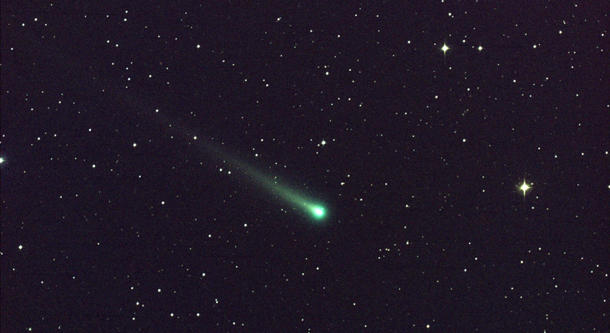This image of C/2012 S1 (Comet ISON) was taken on November 8, 2013.
Depending on where you live and what kind of dark-sky conditions you have access to, this week will be the first opportunity to briefly see Comet ISON with the naked eye. Over the past year, ever since Comet ISON was discovered, news about the comet has been up and down, with predictions that it was going to be a comet of the century and ideas that it was breaking up, fizzling out or just becoming a complete dud. ISON has hung in there, though, and has even had a few surprises for us along the way.
It may not be living up to its initial comet of the century label, but it has defied the most pessimistic of projections. When it emerged from behind the sun in mid-August, it wasn't quite as bright as was hoped, but it was far from done. Then, in early October, just as the comet was making a close pass by Mars, it suddenly burst into colour — changing from white to a vibrant green. More observations, just as it was passing the orbit of Earth at the beginning of November, showed that it is very likely large enough to survive its close pass around the sun, but it also has a very unusual structure, unlike any comet astronomers have ever seen.
Also, just last week, in addition to the tail of dust and debris that it's been sporting for some time, the comet finally sprouted its ion tail — the one that's composed of gases being boiled off from the comet's nucleus. Comet ISON's journey is still fraught with danger. It's a sun-grazing comet, so it will be coming exceptionally close to the sun's surface. Sometimes this is a death dive for icy comets, but some are capable of surviving. NASA Goddard put together a great video about this special class of comets:
As of today, Nov. 13, Comet ISON is now inside the orbit of Venus, and it's already bright enough to be seen through your basic backyard telescope, or even a pair of binoculars will do. Dark-sky conditions are best for viewing, but they aren't necessary. Anyone in a large city will want to get out to at least the suburbs to have a chance to see anything, though. Look to the east, in the hours just before dawn.
The window of opportunity for this first naked-eye sighting of ISON is fairly narrow. It should become bright enough to be visible to the naked eye starting on Nov. 16, for those with excellent dark-sky conditions. It will also grow brighter through the weekend and into next week. However, as the week progresses, the comet will get closer and closer to the sun, and it will become lost in the glare. After that, it will swing around the sun on Nov. 28, and it should emerge again in early December. If it survives (or maybe even if it breaks up), it should give us an even brighter show until some time in mid-January.
(Images courtesy: NASA/MSFC/Aaron Kingery, Stellarium)
.

No comments:
Post a Comment
Through this ever open gate
None come too early
None too late
Thanks for dropping in ... the PICs